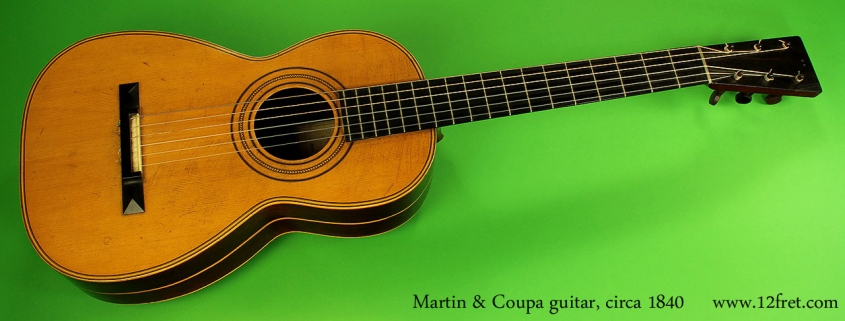| Serial Number | N/A, built in the 1840’s in New York City. |
| Neck | Mahogany neck with unbound ebony fingerboard. Brazilian rosewood headplate with two holes for a leather hanger drilled through; ‘C F MARTIN NEW YORK’ is stamped on back of head., |
| Frets | Original nickel-silver Frets are in good condition. |
| Body | Spruce top, Brazilian rosewood back and sides. Ebony ‘pyramid’ bridge with saddle insert. |
| Finish | Original varnish finish in good condition. |
| Hardware/electronics | Violin or flamenco style friction tuners. |
| Playability/Action | This is a fully playable guitar. |
| Case | Original style wooden ‘coffin’ case included. |
| Comments | Today we feature an absolutely stunning example of a circa 1840 era Martin & Coupa. It is extraordinary that an instrument could be in all original and playable condition, complete with its original “coffin” case, over 160 years after it’s production!!! To give a little chronological perspective, this instrument would have been delivered to its first owner by stagecoach and riverboat 20 years before the American Civil War!This instrument is possibly the most impressive and historically significant guitar ever to grace our store. It features dark Brazilian rosewood back and sides, a delicate herringbone rosette, hand applied varnish finish, slotted peghead, two-piece bridge saddle assembly, rare mid-side marquetry and a delicate fan strutting pattern. It has a surprisingly vibrant voice with good balance and a warm clarity only found in mature instruments.
The internal heel block of this piece appears to be standard dovetail construction but interestingly the heel has a tongue glued to the back so it appears as a “slipper-foot” block and is stamped “CF Martin” “New-York” impressed into the wood but NOT upside down as in later “New York” models. The internal linings are tiny, very even triangle shaped mahogany blocks that are individually glued into place. The blocks are so neatly spaced that at first glance they appear to be modern style “kerfed” linings! The five top braces are arranged in fan shape originating just behind the sound hole and radiating outward under the bridge. The bridge plate is almost nonexistent; approx. 3/32” thick and 1” wide. It is notched away to allow the fan braces to pass through. The entire interior of the body appears to be original without any sign of previous repairs. The joinery and glue work is very neat. On close inspection of the interior of this guitar we discovered 2 very distinct fingerprints on the underside of the top by the sound hole. These were quite likely left by C.F. Martin during the varnishing process!!! The fretboard is ebony with nickel silver “bar frets” that show no significant wear. Incredibly, the neck-set is fine and the action is quite acceptable for a gut-string guitar! The nut is very interesting. It is made from nickle-silver metal and surprisingly heavy. I am convinced it adds significant volume to the open strings. It is only slightly tarnished and has a 3/32” brass locating pin protruding from the bottom that fits a corresponding hole, roughly on the center-line. Martin certainly built this nut to last! The finish of this wonderful instrument appears to be completely original, with some wear and tear on back and several minor scratches on the top; no finish or wood checking of any kind. All glue seams are intact…truly remarkable considering the age of the guitar! The coffin case is in good condition and still very solid. The original black paint covers the interior and exterior of the case. It is fashioned from a fine grained, light colored softwood, possibly Poplar or Tulip wood? There is brown felt glued to the interior and it is completely intact. The case has a tarnished brass handle and brass key-lock. The construction details of this guitar very clearly indicate a transition period in the evolution of early C.F. Martin guitars. It shows a classic, much simpler aesthetic than previous European instruments. The earlier 6-in-line tuners and “clock-key” neck joint, both appointments specific to Martin’s Austrian mentor Johann Stauffer, are gone. This parlor guitar shows many of the appointments of a modern instrument, and yet predates the innovation of the “X” brace and standardized model designations by a decade. To get a clearer picture of the significance of this instrument, an outline of the early history of the C.F. Martin company is probably in order. On January 31st 1796, Christian Frederick Martin was born into a long line of guitar and violinmakers in Markneukirchen, Germany. At age 15 C.F. Martin left his hometown and traveled to Vienna to apprentice with Johann Stauffer, a renowned guitar builder. His apprenticeship was quite successful, to the point that he was eventually appointed Stauffer’s shop foreman. After marrying and having a son, Christian returned home to Markneukirchen and set up his own shop. Because of an acrimonious dispute between the Cabinet Maker’s and Violin Maker’s Guild and the restrictions the Guild system entailed, C.F. decided to leave his homeland. In 1833 Christian Frederick Martin left Germany to take up his craft in New York City. The Martin business’s first address in New York was 196 Hudson St. and was in fact a full line music store selling brass instruments as well as violins. Some labels from this period indicate the building of violins and cellos as well as double basses. Distribution of Martin guitars in these early years was haphazard. Martin entered into distribution contracts with a variety of teachers, importers and wholesalers including Charles Bruno, Henry Schatz and John Coupa. Consequently a number of Martin guitars are labeled “Martin & Schatz” and “Martin & Coupa”. Records show that C.F. Martin’s business relationship with Charles Bruno was very brief. For a seven month period in 1838, Martin had a formal partnership with Bruno and marketed guitars marked C.F. Martin & Bruno on a paper label. John Coupa is mentioned many times in the 1830’s sales books. He was a guitar teacher who had guitars made with Martin & Coupa on the label at least through 1851. During this period, Martin’s “showroom” at 385 Broadway was actually Coupa’s teaching studio. As late as 1881, Coupa’s name appeared in Martin advertisements as one of the “best solo players ever known” who preferred to use Martins. The Label reads: In 1839 C.F. Martin moved his family and business to Pennsylvania. Henry Schatz was a friend of C.F. Martin from Saxony, Germany. Schatz preceded Martin to Pennsylvania in 1835 and was probably a large influence in the Martin family moving to this area. Schatz worked with Martin in Pennsylvania, although there is no record of a legal partnership, there were guitars made with the Martin & Schatz label. The decade immediately following the company’s move to Pennsylvania was a period of change for Martin. C.F.’s own ideas of shape, ornamentation and strutting began. Some unusual features from this time period include a shield shape piece of wood inlaid in the back with the “C.F. Martin, New York” brand. Other guitars from the 1840’s had a strip of wood marquetry around the centre of the sides, dividing the sides into upper and lower halves. The late 1840’s is probably most notable as the time period when Martin first started experimenting with the “X” bracing that has become the standard strutting pattern for almost all modern steel strung guitars! In 1852 to simplify sales and marketing as well as production, Martin standardized body sizes. The largest was Size 1, the smallest Size 3. Larger and smaller sizes, 0 & 4 respectively, were added in 1854. These smaller sizes seemed diminutive even in their day. They were often called terz guitars, a name derived from the Latin tertius, which is the root of the English ‘third’. Terz guitars were typically tuned a minor third higher than standard. In 1856 style designations appeared. With these style designations every Martin acquired a two-part model name with size number and style number separated by a hyphen. Style 17 had rosewood back and sides and a spruce top with coloured wood purfling around the soundhole and several layers of wood binding with rosewood on the outermost layer. Style 18 was also rosewood back and sides with only slightly fancier marquetry. Style 27 had a pearl sound hole ring with top edge trimmed with coloured wood inlaid in a diagonal pattern and outside binding of elephant ivory. Style 28 had a pearl sound hole ring and herringbone purfling. A discussion of this period would not be complete without mentioning Martin’s longest distribution association with C.A. Zoebisch and Sons at 46 Maiden Lane, New York. They became the “depot” or distribution centre for Martins and would maintain an exclusive relationship until 1898. Martin’s address in print ads was the Zoebisch location, and as long as Zoebisch distributed Martins, they were stamped “New York”. This means that even though production was moved to Pennsylvania in 1839, the actual guitars were stamped “New York” until 1898! We would welcome any additional facts regarding this early period in the history of Martin guitars. Anyone with more details relating to early features, historical information and current market value of these 19th century instruments is welcome to email us at sales@12fret.com Thanks to Walter Carter, Mike Longworth and George Gruhn for the historical background on C.F. Martin & Co. |
For more details on this instrument contact us here
You can preview our videos now on Our YouTube Channel!
You can now Visit our Facebook page!
















